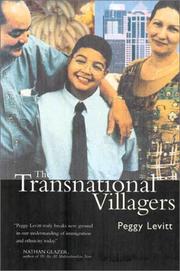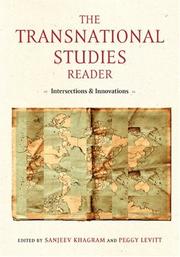| Listing 1 - 10 of 13 | << page >> |
Sort by
|
Book
ISBN: 9780520286078 9780520286061 9780520961456 0520286073 0520286065 0520961455 Year: 2015 Publisher: Oakland, California
Abstract | Keywords | Export | Availability | Bookmark
 Loading...
Loading...Choose an application
- Reference Manager
- EndNote
- RefWorks (Direct export to RefWorks)
What can we learn about nationalism by looking at a country's cultural institutions? How do the history and culture of particular cities help explain how museums represent diversity? Artifacts and Allegiances takes us around the world to tell the compelling story of how museums today are making sense of immigration and globalization. Based on firsthand conversations with museum directors, curators, and policymakers; descriptions of current and future exhibitions; and inside stories about the famous paintings and iconic objects that define collections across the globe, this work provides a close-up view of how different kinds of institutions balance nationalism and cosmopolitanism. By comparing museums in Europe, the United States, Asia, and the Middle East, Peggy Levitt offers a fresh perspective on the role of the museum in shaping citizens. Taken together, these accounts tell the fascinating story of a sea change underway in the museum world at large.
Museums --- Museums and community. --- Musées --- Relations musée-collectivité --- Social aspects. --- Aspect social --- Nationalism --- Social aspects --- Community and museums --- Communities --- Museums - Social aspects --- anthropology. --- art criticism. --- art history. --- asia. --- cosmopolitanism. --- cultural history. --- cultural institutions. --- culture. --- diversity. --- europe. --- exile. --- famous paintings. --- globalization. --- historical artifacts. --- historical memory. --- history. --- icons. --- immigrants. --- immigration. --- middle east. --- museology. --- museum curator. --- museum directors. --- museum exhibitions. --- museum studies. --- museums. --- national identity. --- nationalism. --- nonfiction. --- paintings. --- politics. --- refugees. --- united states.
Book
ISBN: 0197666868 0197666841 9780197666852 Year: 2023 Publisher: New York, New York : Oxford University Press,
Abstract | Keywords | Export | Availability | Bookmark
 Loading...
Loading...Choose an application
- Reference Manager
- EndNote
- RefWorks (Direct export to RefWorks)
Transnational Social Protection considers what happens to social welfare when more and more people live, work, study, and retire outside their countries of citizenship where they received health, education, and elder care. The authors use the concept of resource environment to show how migrants and their families piece together packages of protections from multiple sources in multiple settings and the ways that these vary by place and time. They further show how a new, hybrid transnational social protection (HTSP) regime has emerged in response to the changing environment that complements, supplements, or, in some cases, substitutes for national social welfare systems as we knew them.
Migration, Internal. --- Public welfare. --- Social justice.
Book
Year: 2015 Publisher: Oakland, Calif. University of California Press
Abstract | Keywords | Export | Availability | Bookmark
 Loading...
Loading...Choose an application
- Reference Manager
- EndNote
- RefWorks (Direct export to RefWorks)

ISBN: 9780520228139 Year: 2001 Publisher: Berkeley University of California press
Abstract | Keywords | Export | Availability | Bookmark
 Loading...
Loading...Choose an application
- Reference Manager
- EndNote
- RefWorks (Direct export to RefWorks)

ISBN: 0520228138 Year: 2001 Publisher: Berkeley Los Angeles London : University of California Press,
Abstract | Keywords | Export | Availability | Bookmark
 Loading...
Loading...Choose an application
- Reference Manager
- EndNote
- RefWorks (Direct export to RefWorks)
Émigration et immigration --- Transnationalisme --- Envois de fonds --- Migration --- République dominicaine --- Transnationalisme --- Envois de fonds --- Migration --- République dominicaine

ISBN: 9780415953733 0415953731 9780415953726 0415953723 Year: 2008 Publisher: New York : Routledge,
Abstract | Keywords | Export | Availability | Bookmark
 Loading...
Loading...Choose an application
- Reference Manager
- EndNote
- RefWorks (Direct export to RefWorks)
Mouvements sociaux. --- Problèmes sociaux. --- Relations internationales. --- Organisations internationales.

ISBN: 9780871545176 9780871545169 0871545179 0871545160 Year: 2002 Publisher: New York, NY : Russell Sage Foundation,
Abstract | Keywords | Export | Availability | Bookmark
 Loading...
Loading...Choose an application
- Reference Manager
- EndNote
- RefWorks (Direct export to RefWorks)
Sociology of minorities --- Immigrants --- Transnationalism. --- Transnationalism --- #SBIB:316.8H16 --- #SBIB:39A6 --- Trans-nationalism --- Transnational migration --- International relations --- Welzijns- en sociale problemen: migranten, rassenrelaties --- Etniciteit / Migratiebeleid en -problemen --- TRANSNATIONALISME --- IMMIGRANTS --- ETATS-UNIS
Book
ISBN: 9780197666838 0197666833 9780197666821 0197666825 Year: 2023 Publisher: New York (N.Y.): Oxford University Press,
Abstract | Keywords | Export | Availability | Bookmark
 Loading...
Loading...Choose an application
- Reference Manager
- EndNote
- RefWorks (Direct export to RefWorks)
"How do individuals protect and provide for themselves in a world where so many people live, work, study, and retire outside their countries of citizenship and where many states are reneging on their contract to provide basic social welfare to their citizens? The conventional wisdom is that access to social protections is limited by proximity-membership in the nation-state of residence via citizenship, geographic proximity to the distribution of services within a given territory, and embeddedness in specific local family or social networks all place natural limits on the availability of social protection. We believe this conventional wisdom is sorely out of date. How and where people earn their livelihoods, the communities with which they identify, and where the rights and responsibilities of citizenship get fulfilled has changed dramatically. Societies are increasingly diverse-racially, ethnically, and religiously, but also in terms of membership and rights. There are increasing numbers of long-term residents without membership who live for extended periods in a host country without full rights or representation. There are also more and more long-term members without residence who live outside the countries where they are citizens but continue to participate in the economic and political life of their homelands. There are professional-class migrants who carry two passports and know how to make claims and raise their voices in multiple settings, but there are many more poor, low-skilled, and undocumented migrants who are marginalized in both their home and host countries. Our book analyzes how these changes are transforming social welfare as we know it. We argue that a new set of social welfare arrangements has emerged that we call Hybrid Transnational Social Protection (HTSP). We find that HTSP sometimes complements and sometimes substitutes for traditional modes of social welfare provision. Migrants and their families unevenly and unequally piece together resource environments across borders from multiple sources, including the state, market, nongovernmental organizations (NGOs) and their social networks. Local, subnational (i.e., states and provinces), national, and supranational actors (i.e., regional and international governance bodies) are all potential providers of some level of care. Changing understandings of how and where rights are granted that go beyond national citizenship will aid migrants and non-migrants in their efforts to protect themselves across borders. In fact, we suggest four logics upon which rights are based: the logic of citizenship, the logic of personhood/humanity, the logic of the market, and the logic of community. The conflicts between these different logics are at the core of the contemporary controversies and conflicts over what we can and what we should do to protect dispersed individuals and families from risk, danger, and precarity"--
Transnationalism --- Migration, Internal --- Public welfare --- Social problems --- Social justice
Book
ISBN: 9780199938629 9780199938643 Year: 2013 Publisher: Oxford ; Oxford University Press
Abstract | Keywords | Export | Availability | Bookmark
 Loading...
Loading...Choose an application
- Reference Manager
- EndNote
- RefWorks (Direct export to RefWorks)
Book
ISBN: 9780197666845 Year: 2023 Publisher: Oxford Oxford University Press, Incorporated
Abstract | Keywords | Export | Availability | Bookmark
 Loading...
Loading...Choose an application
- Reference Manager
- EndNote
- RefWorks (Direct export to RefWorks)
Transnational Social Protection considers what happens to social welfare when more and more people live, work, study, and retire outside their countries of citizenship where they received health, education, and elder care. The authors use the concept of resource environment to show how migrants and their families piece together packages of protections from multiple sources in multiple settings and the ways that these vary by place and time. They further show how a new, hybrid transnational social protection (HTSP) regime has emerged in response to the changing environment that complements, supplements, or, in some cases, substitutes for national social welfare systems as we knew them.
| Listing 1 - 10 of 13 | << page >> |
Sort by
|

 Search
Search Feedback
Feedback About UniCat
About UniCat  Help
Help News
News